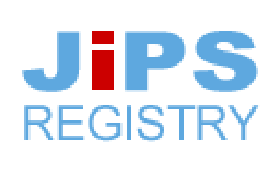Research Design
Research type
JIPS Registry is a multi-site, non-interventional, prospective observation study.
Target case
Newly diagnosed IIPs within 6 months before registration.
Target case number
600-800 patients will be registered for 16 months at approximately 70-80 facilities in Japan.
Sample size
JIPS Registry is an observational study, and no formal sample size was calculated. Descriptive statistical methods will be mainly chosen to analyze the results.
The sample size of INSIGHT-IPF was at least 500 patients and IPF-PRO was 300 patients. Therefore, at least 200 IPF patients who fulfill the diagnostic criteria for IPF will be enrolled in the JIPS registry as it is an adequate number to obtain meaningful outcomes and allows for comparison with other cohorts. Based on the historical volume of two hospitals, in the Tosei General Hospital and Kanagawa Cardiovascular Respiratory Center, which have at least 100 IIPs patients per year, IPF patients comprise approximately 30-40% of IIPs at each facility, providing an expected IPF population of at least 200 patients.
Research period
Registration period:December 2016-March 2018
Tracking period:3 years from the end of the last registration (The maximum observation period will be 52 months.)
Subjects
Inclusion criteria
Patients need to meet all the following inclusion criteria:
- Patients aged between 20 and 84 years
- Patients with IPF and other IIPs diagnosis within 6 months before registration at each facility
- Patients from whom written informed consent has been obtained regarding participation in this study and follow-up observation
Exclusion criteria
Patients with any of the following criteria are excluded from this study:
- Patients for whom the tests (such as the lung function test) conducted in this study could not be performed
- Patients who underwent pulmonary resection
- Patients undergoing dialysis
- Patients with uncured cancer
Registry schedule
This research will consist of a baseline and a follow-up visit at approximately 6-month intervals (6, 12, 18, 24, 30, 36, 42, 48 months) throughout the observational period.
Registry Schedule
Figure-Registry Schedule
-
Data on current practice patterns for IIPs diagnosis
Describe the frequency of surgical lung biopsy, bronchoalveolar lavage, lung function tests, 6-minuite walk test and chest CT.
-
Prevalence of each categorized IIPs
Investigate the prevalence of each categorized IIPs by using the recent and future guidelines.
-
Natural history of each categorized IIPs
Describe the natural history of each categorized IIPs, CT findings, FVC changes, medications, and causes of death.
-
STEP 1
Newly diagnosed idiopathic interstitial pneumonias
-
STEP 2
To verify eligibility in the office
-
STEP 3
Registry
-
STEP 4
To put the information into database
(Registry sheets, HRCT and pathological data) -
STEP 5
MDD conducting within 3 months after registration by the central committee
(IPF, NSIP, UnclassifiableIIPs, COP, et al.) -
STEP 6
Diagnostic central review for unscheduled hospitalization with acute exacerbation.
-
STEP 7
Stable phase
-
STEP 8
Follow up every 6 months
(Blood test, lung function test, et al.) -
STEP 9
Follow up every 12 months
(HRCT, 6WMT, SGRQ, et al.) -
STEP 10
To continue the investigations for 3 years after registry
-
STEP 11
Data analysis, final MDD conducting by the central committee
(Working diagnosis)
Survey Schedule
◎:Mandatory survey item, ○:Survey item
| Survey items | At registration | Every 6 months | Every 12 months | |
|---|---|---|---|---|
| Diagnosis and diagnostic change | ◎ | ◎ | ||
| Data of pathological findings | ◎ | ◯ | ||
| Prognostic information | ◎ | ◎ | ||
| Patient background | ◎ | |||
| Symptoms | ◎ | ◎ | ◎ | |
| Physical findings | ◎ | ◎ | ◎ | |
| Clinical exams | Serum biomarkers | ◎ | ◎ | ◎ |
| Blood tests | ◎ | ◎ | ||
| Autoantibody | ◎ | ◎ | ||
| Arterial blood gas analysis | ◎ | ◎ | ||
| SpO2 | ◎ | ◎ | ◎ | |
| Lung function test | ◎ | ◎ | ◎ | |
| 6-min walk test | ◎ | ◎ | ||
| Electrocardiogram | ◎ | ◎ | ||
| Cardiac ultrasound exam |
◎ | |||
| Image inspections | Chest X-ray | ◎ | ◎ | |
| Chest CT | ◎ | ◎ | ||
| Presence or absence of CPFE | ◎ | |||
| Data of bronchoalveolar lavage | ◎ | ◯ | ||
| Confirmation of home oxygen therapy | ◎ | ◎ | ◎ | |
| Confirmation of respiratory rehab | ◎ | ◎ | ◎ | |
| Clinical events (lung cancer, pneumothorax, pneumonia, etc.) |
◎ | ◎ | ||
| Patient-reported outcome(SGRQ, CAT) | ◎ | ◎ | ||
| Prediction of disease behavior by physician | ◎ | ◎ | ||
| Treatment information | ◎ | ◎ | ◎ | |
| Adverse events | ◎ | ◎ | ||
JIPS REGISTRY


